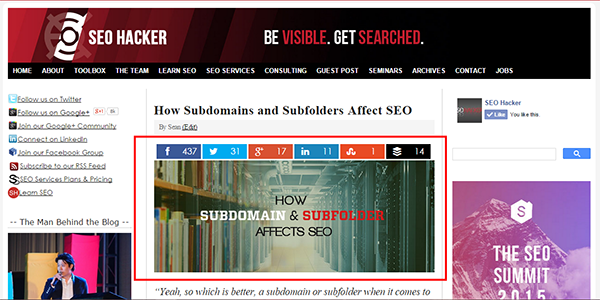6 Common Yet Neglected SEO Techniques that You Should Start Considering
You’ve probably heard the same things over and over – sitemaps, high quality content, title tags and Meta descriptions – and you’re on the prowl for something new.
Note: This article is meant for SEO experts and site owners looking to do more with their site SEO strategy.
In this post, I’ll discuss some common yet neglected techniques that can be employed to make your SEO even more effective.
Of course, don’t expect your rankings to have drastically improved in two days because that’s not how it works. Like every other SEO technique, these tips will help you improve your site’s SEO gradually.
1. Review your link profile regularly
Your link profile is a powerful entity on your site, though it can have a negative effect if you don’t control it. There’s not much you can do about the sites which link to your site (or don’t). Negative SEO attacks are actually quite common. On the flip side, you could have some really good links from high authority sites like .gov and .edu sites.
You should carefully use what control you have to ensure that , like fire, your link profile remains your good servant.
Here’s what you can and should do on a regular basis:
- Scan through the list of sites with backlinks to your site on a schedule. You can get this info using Google Webmaster Tools (GWT). There are also premium services which monitor your link profile and alert you on possible risks.
- Ask low-authority and spammy sites linking to yours to remove those links. A polite request works best – send an email to the site’s webmaster. However, sometimes this may not work – they may fail to respond or ask you to pay.
- Generate a disavow file and submit to Google – this file includes those links you don’t want but are unable to remove, and regardless of the recent confusion surrounding the subject, it still works and should be used when necessary.
2. Include fully optimized videos and images above-the-fold
As you well know, videos and images improve user engagement on a site. What you probably don’t know is that these can improve a site’s ranking in the Universal and/or Image SERPs. On average, pages with images rank higher than those with fewer or no images. The first and second SERP positions give no-image pages higher CTR, but from positions 3-10, it’s a different ball game.
It’s not just about including images and/or videos either, they should also be SE optimized, and here’s how to do it:
- Give the image an appropriate title, adding a major keyword naturally where you can
- Ensure the image is relevant and high quality for users
- Include alternate text
- Make sure the file-size is as small as possible so that your page-load speed isn’t adversely affected. The image size should be appropriate according to the resolution
- Include supporting schema
Videos also show similar behavior in SERP as images. By adding them above the fold, you both add value to site users and improve SERP ranking. High value will therefore improve CTR, reduce bounce rate and increase dwell time, all of which further improve ranking.
3. Ensure your major keywords appear everywhere within the site
Employing your major keywords throughout the site is one of the important SEO techniques that get neglected. It’s not just about having blog posts that mention the keywords here and there. Don’t just have a page or two showing the keyword and neglect the rest of the pages.
Google looks for sites where search query keywords and their semantic variations are supported/promoted throughout the site. To find out the level of occurrence of a particular keyword, follow these steps
a) Go to Google and search for inurl:domain, with the desired keyword/phrase included in speech marks.
b) See how many results are provided by Google.
c) Repeat the above steps with as many of your competitors’ sites as you can for comparison.
Sites with higher site-wide keyword occurrence tend to be ranked higher for said keyword, even where the page authority, domain authority and number of good links are lower than competing sites. This suggests that keyword occurrence is an important factor for Google. Semantic variations are also acceptable – synonyms, tense changes etc.
Last, year Google revealed that site security is among the new factors added into their ranking algorithm. Using HTTPS sites is now an indicator that Google considers. While its impact at present is still small, we expect that it will grow stronger with the passage of time.
Given the recent disruptions that have happened in the recent past, security is now important to users, and Google.
Although data is important to the practice of SEO (especially the one not offered upfront), there must be limits to which we adhere.
If you are able to, add site encryption, which alerts users and search engines through by having ‘https://’ instead of ‘http://’ used for non-secured sites. This lets users know that there’s an extra layer of security, and this may improve your other metrics like CTR, dwell time, and bounce rates.
5. Ensure your URLs are keyword-specific
It’s time to check your URLs if you aren’t ranking for specific keywords. While exact-match domains are now considered a spammy SEO technique, Google still attaches importance to the URL and considers it an indication of relevance to a SE query. You can rank higher by using popular queries in your URL as they are. If you’re using long-tail keywords, you might create specific targeted pages to insert the keyword string into the URL.
6. Include image sitemaps
You probably know all there is to know about XML and HTML sitemaps, but image sitemaps are important too. You’ll be surprised at just how few sites have sitemaps at all. Image sitemaps will especially improve ranking for Google’s Image SERP tab, and it’s not hard. You only need to add information describing your images within the current site XML sitemap.
Your sitemap may include these tag definitions: <image:image>, <image:geo_location>, <image:loc>, <image:license>, <image_title> and <image:caption>. Image sitemaps are a must if you want to boost your image SERP ranking and traffic.
Conclusion
We tend to look at the most complicated things in terms of SEO, neglecting some of the most common techniques that we need to review once in a while.
Share us some of the common SEO techniques that you’re doing even until this moment!
Thank you to Jack Dawson of BigDropInc for collaborating with us in this topic.


